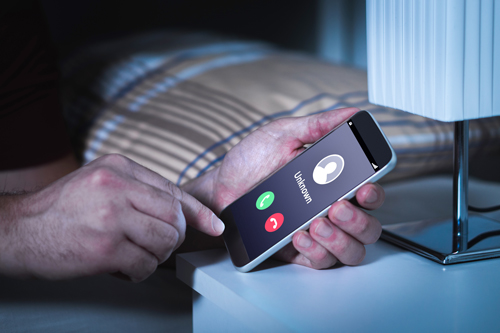Are you sick of grabbing your ringing phone five times a day only to find yet another robocaller on the other end?
If robocalls are getting to you, you’re not alone. Those super-annoying automatic calls have recently exploded, and it’s enough to make anyone go bonkers. More than 30 billion robocalls were made in the United States in 2017, and the Federal Trade Commission answered a whopping 375,000 complaints about robocalls each month.
Unfortunately, those numbers are only rising.
If you feel like your phone is ringing off the hook from robocalls and you’re just about ready to throw it against the wall, read on. We’ll give you the inside scoop on these dreaded calls and show you what you can do to put a stop to them once and for all.
How do they have my number?
Many people ask how so many businesses and scammers have their number. It’s because robocalls are becoming increasingly more sophisticated and the internet is making their job easier. Scammers and telemarketers can scrape almost anyone’s phone number off the web.
They might find it on your Facebook page, another social media platform you frequent, or even drag it off your business’s website. Robocalls also buy phone numbers from popular companies or websites that require visitors to log in by submitting some basic personal information that includes their landline and cellphone numbers.
Or, robocalls may simply be dialing thousands and thousands of numbers at random, with no rhyme or reason at all.
Who’s on the other end of the line?
Robocalls come in many forms. Sometimes they’ll be trying to sell you a product or urge you into signing up for a service. Other times, they’ll try to scam you by appearing to represent a government agency, like the IRS.
You might think no one’s buying the marketed product, or that whoever actually believes the robotic voice telling them they’re about to be arrested is super naïve. Remember, though, that even if just a few people agree to buy the product or are taken in by the scam, the minimal cost of running the calls is more than worth it for the person behind the calls.
Here’s how the robocalls take a stab at appearing authentic:
-
Spoofing. Using software, the robocaller can tweak the way their number shows up on caller ID. They can make it look like the IRS is on the phone, that your electric service company is calling you or like a representative from Apple is seeking you.
Recently, scammers have been using neighbor-spoofing, in which their caller ID looks like a local number. This throws victims off and can help robocalls gain their misplaced trust.
-
Disguised identity. Robocalls may also choose to appear mysterious and show up on your caller ID as “private number,” “unavailable” or “unknown.”
Steps you can take
Thankfully, you don’t have to be bombarded by those irksome calls for the rest of your life. Here are several steps you can take to keep most robocalls from reaching your landline or cellphone:
-
Don’t answer calls from unfamiliar numbers – If you don’t recognize the number on your caller ID, let it go to voicemail. If the ID shows a local number or the name of a recognized company you have no reason to believe is calling you, ignore it as well.
-
Block unwanted numbers – It’s time to get offensive and start intercepting those numbers before they reach your phone. First, if there’s any specific number that calls you persistently, use your phone to block it and you won’t have to hear from them again. Next, check with your phone service provider about possible technologies you can download to block anonymous calls or those from specific area codes. Some systems allow you to create your own blacklist of numbers that will be blocked or sent directly to voicemail. You can also create a “white list” of numbers you allow to go through and stop every other number from reaching you. You may also want to enlist the help of a robocall-blocking app that can offer you a stronger defense against unwanted calls.
-
Require caller input – To keep all automatic calls from reaching your phone, you can set up a call-blocking technology, such as the Sentry Active Call Blocker, that greets all callers with a message requiring them to enter a number before the call can proceed. That’s something robots can’t yet do.
-
Don’t share your number – Never share your phone number on your social media profiles or pages. If a business asks for your number, do not give it out unless you absolutely must.
-
Sign up for the Do Not Call Registry – Visit www.donotcall.gov to add your landline and cellphone numbers to the list of registered callers who don’t want to be bothered by telemarketers. Scammers won’t pay much attention to this list, but law-abiding companies that ignore the listed numbers risk being fined and will usually abide by the registry’s rules. This service is free, and your number will never be taken off the list.
-
File a complaint – If you’ve signed up for the Do Not Call Registry and, after a month, you are still receiving robocalls from specific companies, file a complaint with the FTC at ftc.gov. When the agency receives enough complaints about a number, it will take action. If you’re constantly receiving unwanted calls from a known business after signing up for the Do Not Call Registry, you can file a complaint with the Better Business Bureau.
You don’t have to let those robocalls overtake your life. Take action today and reclaim your peace!



